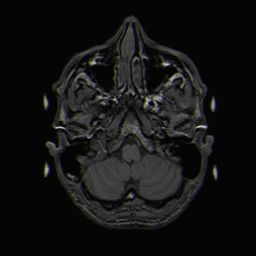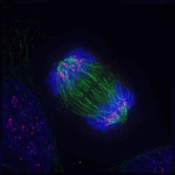Difference between revisions of "Abnormal Cellular/Synaptic Growth Hypothesis"
(→75pxNeuroimaging) |
|||
| Line 9: | Line 9: | ||
==[[Image: Brain_MRI_T1_movie.gif|75px]]Neuroimaging== | ==[[Image: Brain_MRI_T1_movie.gif|75px]]Neuroimaging== | ||
| − | + | During the first year of birth, brains of people with ASD often show increased brain volume and head circumference. Most of the additional growth is in the frontal lobes. Retrospective studies have shown that head circumference of people with ASD are normal at birth, there have been no studies on size of prenatal or neonatal ASD brain volume. <sup></sup> | |
==[[Image: Anaphase_IF.gif|75px]]Genetics== | ==[[Image: Anaphase_IF.gif|75px]]Genetics== | ||
Revision as of 14:31, 25 March 2010
Contents
Abnormal Cellular/Synaptic Growth Hypothesis
This hypothesis came about from studies on single gene disorders where patients with the disorder have a high incidence rate of ASD, like fragile X with an ASD prevalence rate of 15% and Tuberous sclerosis, which has a prevalence rate anywhere between 25%-60%. Studies of these disorders can illuminate which biological pathways may be responsible for ASD phenotypes.
Studies of Tuberouse Schlerosis and Cowden/Lhermitte-Cuclos Syndromes found that the two syndromes associate susceptibility to Autism Spectrum Disorders with macrocephaly.1 Macrocephaly is relatively common among ASD patients with an estimated prevalence rate of 15-35%.2
Tuberouse Schlerosis and Cowden/Lhermitte-Cuclos Syndrome are caused by NF1, TSC1/TSC2, and PTEN. The tuberous schlerosis complex has GAP activity against GTP binding protein Rheb which results in the inhibition of rapamycin kinase (mTOR). These proteins act as negative effectors of mTORC1, which is a major regulator of cellular growth in mitotic cells. It is thought that mutations enhance the MTORC1 complex which is activated by a sequential kinase cascade downstream of the phosphoinositide-3 kinase pathway. This pathway can be modulated by serotonin.1
 Neuroimaging
Neuroimaging
During the first year of birth, brains of people with ASD often show increased brain volume and head circumference. Most of the additional growth is in the frontal lobes. Retrospective studies have shown that head circumference of people with ASD are normal at birth, there have been no studies on size of prenatal or neonatal ASD brain volume.
 Genetics
Genetics
Animal Models
References
1. Bourgeron T. A synaptic trek to autism. Curr Opin Neurobiol. 2009 Apr;19(2):231-4 PMID 19545994
2. Williams CA et. al. Genetic disorders associated with macrocephaly. Am J Med Genet A. 2008 Aug 1;146A(15):2023-37. PMID 18629877